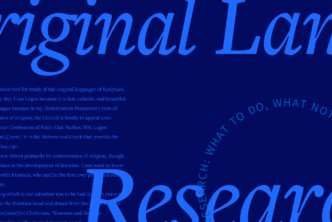A group of European designers recently released something called Bible The. They took all the words of the King James Bible and rearranged them in alphabetical order. Bible The—get it?
Bible The presents 18 pages of the word “shall,” one instance of “pygarg,” and half a page of the word “suburbs”! Did you even know that word was in the KJV?
I work for the maker of Logos Bible Software, and I therefore find the promotional words for Bible The to be both stirring and suspect:
“A book is just a collection of words placed in a specific sequential order. A complex literary algorithm crafted by its author. … What if we could beat that algorithm? Turn a book into something objective. Quantifiable. Analytical. So we can study the individual parts and learn new ways to read a text.”
Now there’s real truth here. Quantifying and analyzing the Bible the way computers do really can bring new insight. I search the Bible in Logos all the time, and I even have it graph the results occasionally.
But that language about turning the Bible into something quantifiable, analytical, and objective doesn’t feel right. Just think of all the ways this could go wrong. Think of what people might conclude by reading Bible The instead of the Bible:
- There are five pages of “all.” Yes, “all” God’s promises are true, and God is underlining this fact!
- The 78 pages of the definite article, “the,” show that God is very interested in definiteness, in pointing out precisely what he means—this object, and not that; this truth, and not that lie.
- There’s also a whole page I’m going to read to my littlest boy during devotional time at dinner, because he is picky and slow with his food: eat, eat, eat, eat, eat, eateth!
Every one of these little “arguments” I’ve just made is ridiculous, even if the conclusions are in some cases true. The Bible The website says that the words of Bible The “speak for themselves. … And the data does not lie.” But that’s wrong wrong wrong wrong wrong wrong wrong wrongeth wrongfully. You can’t draw any legitimate and useful conclusions from a list of words—if that’s all you have.
The Bible says what it says through sentences, paragraphs, sections, stories, books, and the overall story of Scripture. Bible The, by itself, is meaningless. There are no promises of God in it. Not one. There is no definiteness and no ambiguity. “Christ” is in it 571 times, but really he’s not in it at all. There’s no meaning in Bible The. A list of words in alphabetical order is not a book, much less a Bible. Turning the Bible into something objective and analyzable risks making it a blank slate you can write your own ideas on.
But if you know the Bible well, then the analysis in Bible The might actually help you see something you haven’t seen before—something that you can go back to the Bible’s sentences to confirm. I saw a big chunk of the word “atonement,” and I thought, “Wow, I usually connect ‘atonement’ to Christ, so it’s kind of neat to see the Old and New Testament uses of it all put together.” This sent me on a little Bible study binge. I studied “atonement” in Logos. I used dictionaries and other reference works to look up related words.
But I didn’t stop at the word level; I learned the lesson of Bible The many years ago: I made sure to read sentences and paragraphs about Christ’s atonement. I noticed that the New Testament uses the word very little—perhaps because it has so many other important concepts for what happens at salvation? God “reconciles” us to himself, for example; his wrath is “propitiated.”
Bible The helped me see something in the Bible by viewing the Bible from an analytical angle. And that’s what the tools in your Bible software are supposed to do, too. They’re not meant to be used apart from reading Scripture. You can’t skip right from word statistics to theology or life application.
(But I’m going to wait a while before I admit to my children that eat, eat, eat, eat, eat isn’t in the Bible.)

***
This article was originally published in the May/June 2021 issue of Bible Study Magazine. Slight adjustments, such as title and subheadings, may be the addition of an editor.
Related articles
- Is the Bible True? Explaining That the Bible Is God’s Word
- How to Study the Bible: 9 Tips to Get More Out of Your Study
- 29 Bible Study Tools for Reading the Bible More Effectively
Related resources






